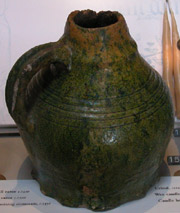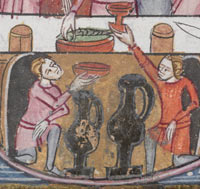 |
 |
 |
 |
 |
 |
 |
|
Fountains Abbey: History
Fountains Abbey: Buildings
|
Visitors (5/5) A wide range of visitors would have enjoyed hospitality at Fountains, and the community earned a reputation for its reception of guests and care for the poor. Abbot John was commended for his participation with guests, and his predecessor, Robert of Pipewell, for his reception of strangers and pilgrims and for showing appropriate honour to guests. The archbishop of Norway was certainly impressed after his visit to Fountains in 1146, and arranged for a colony of the monks to return with him to found an abbey at Lysa, near Bergen. Henry III (1216-1272) was evidently satisfied with the hospitality he had received from the monks in 1244 and to show his gratitude, he granted the community three casks of wine, one for the celebration of the Mass, one for the monks’ infirmary and one as a refectory pittance.(114) In addition to dignitaries, Fountains would have welcomed friends and families of the monks and lay-brothers, visiting Cistercians and, of course, passers-by. Indeed, Fountains’ proximity to Ripon and York, and to a network of roads, would have ensured a steady flow of visitors. Inevitably, the administration of hospitality could be a drain on the monastery’s resources, a fact acknowledged by the king in the late thirteenth century, when Fountains was suffering financial difficulties. The king warned his officials not to deplete the community by staying either at the abbey or on any of its granges.(115)
The Beaulieu Account Book, compiled c. 1270, includes a comprehensive list of the various kinds of guests who might visit the community, and states how they ought to be provided for during their stay. It encompasses a wide range of visitors, for example, royalty and barons, church dignitaries, monastic officials and clerics, messengers, mariners and grooms.(116) Relatives of the monks and lay-brothers would also have visited the abbey and were permitted to stay for two days twice a year.(117)
By the later Middle Ages the abbot of Fountains was a man of prominence within the locality, and would have entertained noteworthy guests lavishly in his magnificent residence. The account books from John Greenwell’s abbacy indicate that he, and those whom he entertained, lived and dined in style, feasting on figs, walnuts, pears, fish and oysters, as well partridges, quails and venison.(118) When Greenwell entertained the earl of Northumberland (1457-8), he served a sumptuous spread of swans and other birds costing twenty-seven shillings.(119) Lord William Scrope had previously dined on fresh fish which was purchased at Bury for nine-pence.(120) Abbot Greenwell’s successors evidently dined just as finely, for excavations in the nineteenth century uncovered a hoard of bones and shells – beef, mutton, pork and venison bones, oyster, mussel and cockle shells.(121) The account books also record payments to minstrels, story-tellers and other entertainers, including players from Thirsk and Ripon, a fool from Byland, and ‘a strange fabulist’.(122) Whilst not explicit, it is likely that this entertainment was enjoyed by Fountains’ guests. [Read more about the reception of guests at Cistercian houses] |

